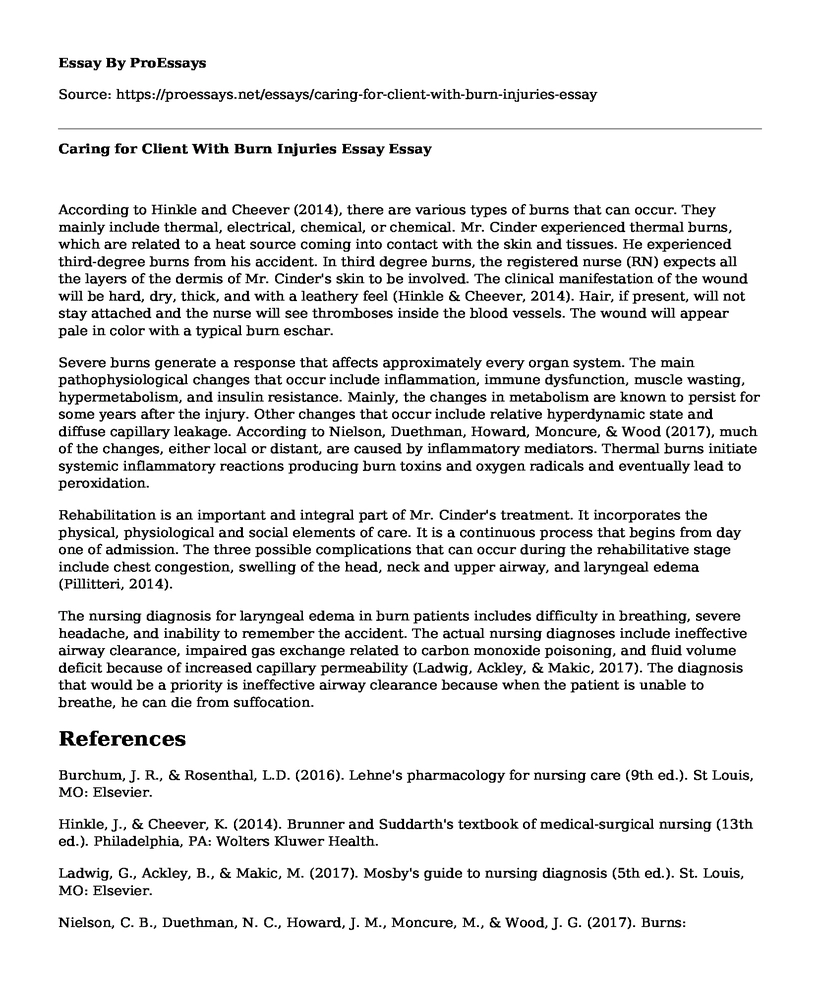According to Hinkle and Cheever (2014), there are various types of burns that can occur. They mainly include thermal, electrical, chemical, or chemical. Mr. Cinder experienced thermal burns, which are related to a heat source coming into contact with the skin and tissues. He experienced third-degree burns from his accident. In third degree burns, the registered nurse (RN) expects all the layers of the dermis of Mr. Cinder's skin to be involved. The clinical manifestation of the wound will be hard, dry, thick, and with a leathery feel (Hinkle & Cheever, 2014). Hair, if present, will not stay attached and the nurse will see thromboses inside the blood vessels. The wound will appear pale in color with a typical burn eschar.
Severe burns generate a response that affects approximately every organ system. The main pathophysiological changes that occur include inflammation, immune dysfunction, muscle wasting, hypermetabolism, and insulin resistance. Mainly, the changes in metabolism are known to persist for some years after the injury. Other changes that occur include relative hyperdynamic state and diffuse capillary leakage. According to Nielson, Duethman, Howard, Moncure, & Wood (2017), much of the changes, either local or distant, are caused by inflammatory mediators. Thermal burns initiate systemic inflammatory reactions producing burn toxins and oxygen radicals and eventually lead to peroxidation.
Rehabilitation is an important and integral part of Mr. Cinder's treatment. It incorporates the physical, physiological and social elements of care. It is a continuous process that begins from day one of admission. The three possible complications that can occur during the rehabilitative stage include chest congestion, swelling of the head, neck and upper airway, and laryngeal edema (Pillitteri, 2014).
The nursing diagnosis for laryngeal edema in burn patients includes difficulty in breathing, severe headache, and inability to remember the accident. The actual nursing diagnoses include ineffective airway clearance, impaired gas exchange related to carbon monoxide poisoning, and fluid volume deficit because of increased capillary permeability (Ladwig, Ackley, & Makic, 2017). The diagnosis that would be a priority is ineffective airway clearance because when the patient is unable to breathe, he can die from suffocation.
References
Burchum, J. R., & Rosenthal, L.D. (2016). Lehne's pharmacology for nursing care (9th ed.). St Louis, MO: Elsevier.
Hinkle, J., & Cheever, K. (2014). Brunner and Suddarth's textbook of medical-surgical nursing (13th ed.). Philadelphia, PA: Wolters Kluwer Health.
Ladwig, G., Ackley, B., & Makic, M. (2017). Mosby's guide to nursing diagnosis (5th ed.). St. Louis, MO: Elsevier.
Nielson, C. B., Duethman, N. C., Howard, J. M., Moncure, M., & Wood, J. G. (2017). Burns: pathophysiology of systemic complications and current management. Journal of Burn Care & Research, 38(1), e469-e481.
Pillitteri, A. (2014). Maternal and child health nursing: Care of the childbearing and childrearing family (7th ed.). Philadelphia, PA: Lippincott Williams & Wilkins.
Cite this page
Caring for Client With Burn Injuries Essay. (2022, May 26). Retrieved from https://proessays.net/essays/caring-for-client-with-burn-injuries-essay
If you are the original author of this essay and no longer wish to have it published on the ProEssays website, please click below to request its removal:
- Medicine Essay Sample: Human Immunodeficiency Virus (HIV)
- Adoption of New Technology Systems in Nursing - Essay Example
- Reasons Why the US Citizens Are Rapidly Becoming More Obese Essay
- Essay Sample on Ethics and Nursing Practice
- Fair Pricing for Pharmaceuticals: Balancing Profits and Health Outcomes - Essay Sample
- Overcoming Glossophobia: Public Speaking for Nurses - Essay Sample
- Essay Sample on Healthcare System







